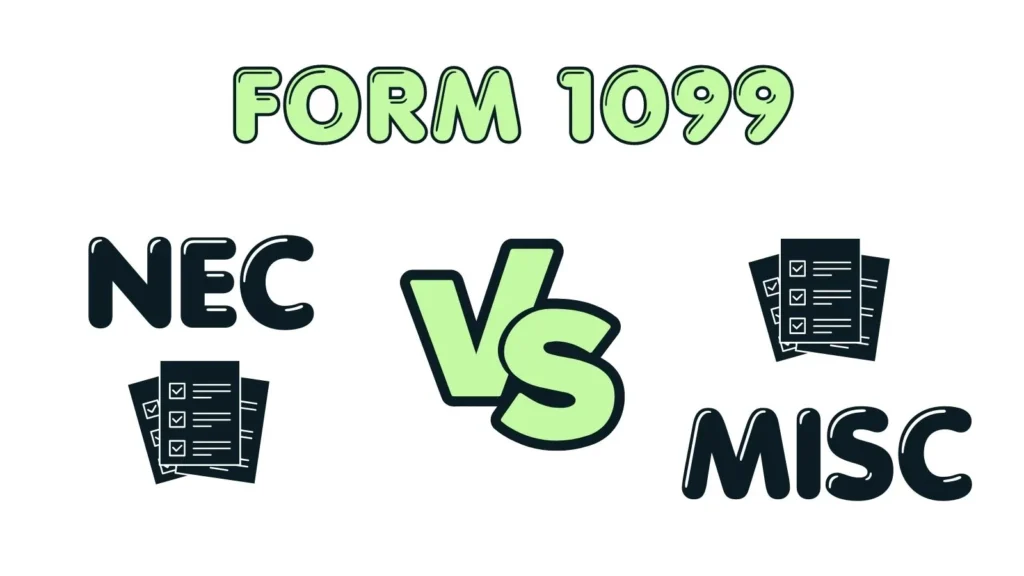Understanding the differences between Form 1099-NEC and Form 1099-MISC is crucial for businesses and self-employed individuals during annual tax filings. Using the correct form ensures accurate reporting, maximizes benefits, and helps avoid potential penalties. This guide explores the specifics of each form, including who needs to use them, filing deadlines, proper filing procedures, and answers to frequently asked questions.
What is Form 1099-NEC?
Form 1099-NEC is used for reporting non-employee compensation. It’s used when a business pays an independent contractor or freelancer $600 or more in a calendar year for services rendered. This includes payments to individuals, partnerships, and certain LLCs. The form was reintroduced in 2020 to simplify tax reporting by separating non-employee compensation from other types of payments previously reported on the 1099-MISC.
Who Needs to Use a 1099-NEC?
If your business paid a contractor $600 or more in the tax year, you must file Form 1099-NEC. However, if your independent contractor is registered as a C corporation or S corporation, a 1099-NEC is not necessary. You can find this information on the contractor’s Form W-9.
Do not file a 1099-NEC for employees. Employees should receive a Form W-2. Misclassifying employees as contractors can result in significant penalties.
What is Form 1099-MISC?
Form 1099-MISC is a broader information return used to report various types of payments made in the course of business that do not fall under non-employee compensation. Payments reported on this form can include rent, legal fees, prizes, awards, and other types of income that do not involve direct services rendered to the business.

Who Needs to Use a 1099-MISC?
Businesses are required to file Form 1099-MISC for miscellaneous payments made during the tax year to each person who is not an employee and isn’t subject to self-employment tax:
- At least $10 in royalties or broker payments in lieu of dividends or tax-exempt interest.
- At least $600 in miscellaneous payments such as rents, prizes and awards, medical and health care payments, other income payments, legal settlements, and other qualifying reimbursements.
Additionally, if you sell at least $5,000 of consumer products to a buyer for resale anywhere other than a permanent retail establishment, you must report the sale by checking item 9 on Form 1099-MISC.
States That Do Not Require 1099 Forms
Some states do not require 1099 forms at the state level. These states include:
- Alaska
- Florida
- Illinois
- Nevada
- New Hampshire
- New York
- South Dakota
- Tennessee
- Texas
- Washington
- Wyoming
Always check for updates or changes in tax legislation, as states can revise their requirements.
What is the Deadline for Filing 1099-NEC and 1099-MISC?
Form 1099-NEC must be filed with the IRS by January 31 of the year following the applicable tax year. Form 1099-MISC is due to the recipient by January 31 and must be filed with the IRS by February 28 (paper) or March 31 (electronic).
What Are the Penalties for Missing the Deadline?
Penalties for late filing can range from $50 to $280 per form. To request an extension for filing Form 1099-NEC, submit Form 8809 to the IRS. Remember, even with an extension, you must still provide the 1099-NEC forms to your contractors by January 31.

How to File a 1099-NEC and 1099-MISC Properly
Proper filing is essential to ensure compliance. Follow these steps:
- Ensure Your Contractor Completes Form W-9
- Choose Your Filing Method (e-file or paper file. Form 1096 is needed for paper filing.)
- Prepare Your 1099 Forms
- File and Send Appropriate Copies (IRS: Copy A; State Tax Agency: Copy 1; Contractor: Copies B and 2)
- Retain a Copy for Your Records (Copy C)
Additional Considerations:
- Understand the Purpose of Each Copy
- Clarify Responsibilities
- Verification of Payments
- Utilize Payroll Services
Frequently Asked Questions (FAQ)
1. How can I request an extension for filing Form 1099-NEC?
Submit Form 8809 to the IRS. Remember, you must still provide the 1099-NEC forms to your contractors by January 31.
2. What additional tax forms should I be familiar with?
- Form 1099-K
- Form W-9
- Form 8829
- Form 4868
3. Can I use Form 1099-MISC instead of 1099-NEC?
No. Using the incorrect form may result in penalties.
4. Why did I receive Form 1099-NEC instead of Form 1099-MISC this year?
Form 1099-NEC was reintroduced in 2020 for reporting non-employee compensation.
5. Who is responsible for filing Form 1099-NEC?
The payer (business) is responsible.
6. How do I file Form 1099-NEC?
- Collect Contractor Information
- Choose Filing Method
- Prepare the Form
- Distribute Copies
- Retain Records
7. How do I submit Copy B of Form 1099-NEC to the contractor?
Mail or send electronically with consent.
8. How do I submit Copy A of Form 1099-NEC to the IRS?
By mail (with Form 1096) or electronically (using FIRE).
Conclusion
Understanding the distinctions between Form 1099-NEC and Form 1099-MISC is essential for accurate tax reporting and compliance. If you need assistance, consider professional help.
Additional Resources
Need help with your 1099s?
XOA TAX can help simplify your tax preparation. Contact us today!
- Website: https://www.xoatax.com/
- Phone: +1 (714) 594-6986
- Email: [email protected]
- Contact Page: https://www.xoatax.com/contact-us/




 anywhere
anywhere  anytime
anytime